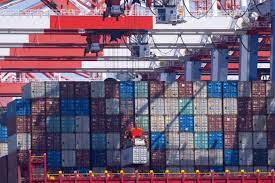Ranvir S. Nayar
Barely four months before the next global climate change summit, COP28, gets underway in Dubai and with all alarms ringing out loud, the global shipping industry this month underwhelmed climate watchers with its vague promises and commitments at a meeting organized by the International Maritime Organization, the global maritime regulator and an agency of the UN.
Exactly how much shipping accounts for in terms of climate change is a highly debated issue. Firstly, it is only international shipping that is taken into account, even though a large part of the shipping in many countries that have large rivers or coastal areas is domestic. International shipping accounts for about 3 percent of global greenhouse gas emissions, the same as Europe’s largest economy, Germany. At the IMO meeting, the global shipping industry agreed to reduce emissions of planet-warming gases to net zero “by or around 2050.”
This has roiled environmentalists around the world, who point to the similarly loose language and lack of firm and enforceable commitments made at the COP21 summit in Paris in 2015. This stands in tatters today as practically every single signatory has failed to come anywhere near meeting the commitments made in Paris. This has created a situation where most experts, including the Intergovernmental Panel on Climate Change, the body mandated by the UN to track climate change, has said that a 1.5 degrees Celsius rise in global temperatures – the red line for planetary safety – is set to be breached within a couple of years and that the rise in temperatures by the turn of this century could be as high as 3 C or even 4 C above the pre-industrial era, creating a catastrophic future for the world.
In such a situation, it is distressing to see a major sector of the economy trying to fudge its way through without making any commitments or sacrifices in terms of short-term profits in exchange for long-term gains for the entire planet. For now, the shippers have promised to “try and cut their emissions as close as possible to zero by around 2050.” Try and find an international agreement with less commitment, let alone enforceability, which has turned out to be a fatal flaw in the Paris Agreement, as many had feared even in 2015, when global leaders opted for a loosely worded agreement that was not worth the paper it was signed on. In Paris, the “agreement” was signed for public consumption so that the global leaders assembled there could come out looking like they were committed to fighting climate change, even though it was clear to anyone who cared to read the details of the agreement that it was a dud.
Almost a decade later, the world is paying a heavy price for that deal and now the shipping industry has rather disingenuously tried to ape the language of Paris and is similarly trying to present it as a pathbreaking agreement that will turn the industry into a climate savior. Nothing could be further from the truth. In the next seven years, the shipping industry needs to cut its emissions by 15 percent in order to be on track for a net zero scenario by 2050. But the trajectory of emissions has been progressing in the other direction. In 2022, global shipping emissions rose by 5 percent to reach 706 million tons, close to the peak of 708 million tons seen in 2018 and nearly 50 percent above the 504 million tons recorded at the turn of the century.
The emissions are almost certainly going to be even higher in 2023 if the expansion of the global economy is any indication, as it means more trade and that means more shipping. With each passing year, the target of a 15 percent cut in emissions by 2030 looks increasingly laughably unrealistic. Reducing emissions will be an uphill task for the shipping industry, as it uses the heaviest of fuels that are loaded with carbon and which have among the highest emissions per unit of fuel consumed. Replacing these fuels with lower-emission ones like biofuels may be technologically feasible, but would significantly increase operational costs in the industry, which is almost always in a fragile financial state and which is just about recovering from the pandemic shock that severely impacted global trade for at least 18 months.
While the shipping industry may point to the COVID-19 pandemic as the main reason for it being slow in adopting climate-friendly technologies, it has been lethargic on this issue for a long while. It is among the slowest of all industries to move toward green technologies. For instance, even as the aviation and automobile industries are moving, even if at varying speeds, toward battery-powered aircraft, cars and even trucks, for the shipping industry, these elements have remained primarily in the corporate boardrooms or at best on the design blueprints. There are hardly any ships currently on the oceans that are not running on traditional, highly polluting oils. Shipbuilders ought to rapidly increase their investments in developing vessels powered by batteries, renewable energies like biofuels or hydrogen, or perhaps even nuclear power, as some advocate. But that is likely to open up another debate about how safe the world would be with hundreds of small nuclear reactors floating around the globe, when each is capable of inflicting catastrophic damage to a large area. There are some solutions already in place that can cut about 5 percent of the shipping industry’s emissions. First is to retrofit ships so that they can use shore-side power when they are in port, instead of using their own highly polluting diesel.
There are some ports with power facilities, but this also needs to be expanded. A switch to biofuels is also feasible, though expensive, but if the aviation industry can start adopting sustainable aviation fuel, which is also a biofuel, there is no reason the shipping industry should remain anchored in its old practices. Unfortunately, the shipping industry can only be moved by tightening the agreement reached at the IMO meeting. Until then, the smokestacks will continue to billow poisonous gases into the atmosphere.







